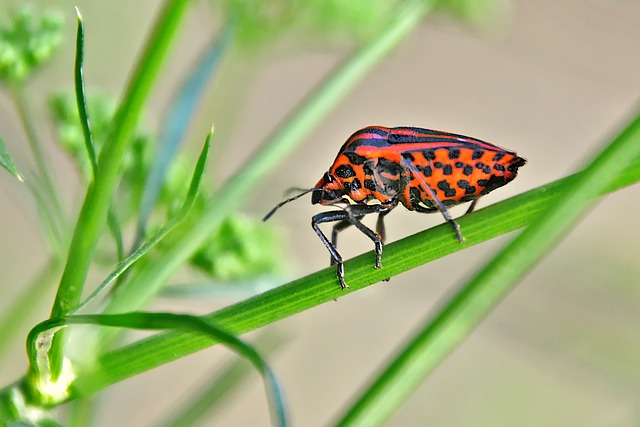Stink bugs, known for emitting strong odors when disturbed, can become a nuisance by invading homes during fall and winter. Professional stink bug control services offer humane and eco-friendly solutions including sealing entry points, using sticky traps, and applying natural insecticidal essential oils like neem, peppermint, and eucalyptus. These methods complement the introduction of natural predators and maintaining a clean living space to deter stink bugs effectively without resorting to toxic pesticides. When dealing with infestations, professionals provide tailored strategies, targeted treatments, and long-term prevention plans, ideal for severe cases or unique circumstances, while DIY solutions offer basic repellents and cleaning practices for less intense scenarios.
Stink bugs have become a growing pestilence, but it’s time to approach their removal with a balance between effectiveness and ecological responsibility. This article explores humane and eco-conscious methods to combat these pesky critters. We delve into understanding their behavior and habitat, offering non-toxic solutions for DIY enthusiasts. Additionally, we highlight eco-friendly products and practices for a greener approach to stink bug control. Whether opting for professional services or taking matters into your own hands, discover the best strategies for effective yet sustainable stink bug removal.
Understanding Stink Bugs: Behavior and Habitat
Stink bugs, scientifically known as Heminocera spp., are insects that have gained notoriety for their defensive mechanism—emitting a pungent odor when disturbed. These creatures are not inherently harmful to humans or structures but can become a nuisance due to their tendency to invade homes and buildings during certain times of the year. Understanding their behavior is crucial in implementing effective stink bug control services. They are attracted to warm, moist environments and often seek shelter in cracks, crevices, and voids of houses, especially during fall and winter. Stink bugs are not selective; they can infest residential properties, commercial spaces, and agricultural areas alike.
Knowing their habitat preferences allows for targeted stink bug control measures. Professional pest control services employ various eco-conscious methods to manage these insects, such as sealing entry points, using sticky traps, and applying targeted pesticides when necessary. By addressing the root causes of infestation and employing humane techniques, stink bug control services can ensure a comfortable living space while maintaining ecological balance.
Non-Toxic, Humane Methods for Stink Bug Control
When it comes to managing stink bugs, there are humane and eco-friendly alternatives to toxic pesticides that can be effective in controlling these pesky invaders. These non-toxic methods offer a safer approach for both your family and the environment while ensuring the well-being of beneficial insects. One such strategy involves using essential oils, which have natural insecticidal properties. Oils like neem, peppermint, and eucalyptus can deter stink bugs when applied to entry points and problem areas.
Another eco-conscious option is to introduce natural predators into your space. For example, certain species of spiders and insects feed on stink bugs. Encouraging these predators through the use of insect hotels or carefully placed traps can help keep stink bug populations in check. Additionally, sealing gaps and cracks around windows and doors can prevent their entry, making it easier to maintain a stink-bug-free environment without resorting to harmful chemicals. Opting for these non-toxic stink bug control services is beneficial for both your health and the longevity of our planet’s ecosystem.
Eco-Friendly Products and Practices for Stink Bug Removal
When it comes to dealing with stink bugs, there are eco-friendly alternatives to traditional pest control methods. Many stink bug control services now offer natural solutions that are safe for both your family and the environment. These include using essential oils like peppermint, cinnamon, or clove, which repel stink bugs due to their strong scent.
In addition to natural repellents, sealing entry points and maintaining a clean living space are crucial. Stink bugs enter homes through cracks and gaps, so caulking windows and doors can prevent their access. Regularly cleaning areas where stink bugs breed, such as under appliances and in dark corners, helps reduce their population. Using eco-friendly products for cleaning ensures that no harmful chemicals are introduced into your living space or left behind to potentially attract more pests.
Professional vs DIY: Choosing the Right Stink Bug Control Service
When considering stink bug removal, the decision between professional services and DIY methods is an important one. Professional stink bug control services offer a comprehensive solution tailored to your specific needs. These experts are equipped with advanced tools and knowledge of the latest eco-conscious techniques, ensuring efficient and effective treatment. They can identify entry points, locate nests, and implement targeted strategies to eliminate stink bugs from your space.
Opting for professional help is particularly beneficial for severe infestations or unique circumstances. DIY methods may provide basic solutions, but they might not address the root of the problem. Professionals can offer long-term prevention plans, regular inspections, and eco-friendly products to disrupt the lifecycle of stink bugs without causing harm to people or pets. This personalized approach makes professional stink bug control services a wise choice for those seeking swift relief and lasting protection.
When dealing with stink bugs, a thoughtful and sustainable approach is key. By understanding their behavior and habitat, we can employ non-toxic, humane methods and eco-friendly products for effective removal. Whether opting for professional stink bug control services or choosing DIY solutions, prioritizing the well-being of both humans and the environment ensures a harmonious coexistence with these creatures. Remember, when it comes to stink bug control, there’s always a better way that respects both nature and our neighbors.
